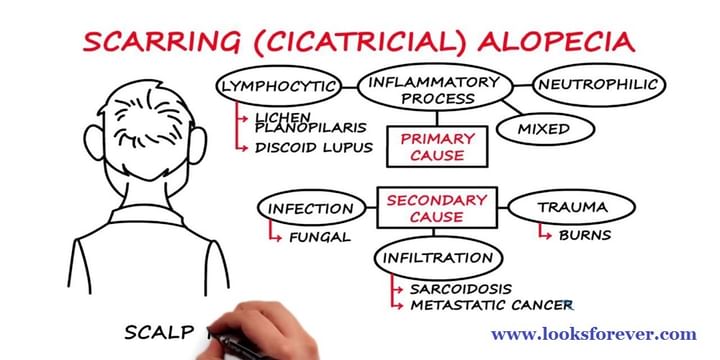What is Scarring Alopecia?
Scarring Alopecia, otherwise called Cicatricial Alopecia, alludes to a gathering of hair loss issue that might be diagnosed in up to 3% of hair loss patients. It happens worldwide in generally healthy men and women of any age.
Every particular diagnosis inside this class is genuinely uncommon, yet a few cases incorporate analyzing Cellulitis, Eosinophilic Pustular Folliculitis, Follicular Degeneration Disorder (beforehand called "Hot Brush" Alopecia), folliculitis decalvans, lichen planopilaris, and pseudopelade of Brocq, to give some examples. Scarring Alopecia may likewise be a piece of a significantly bigger condition, for example, Chronic Lupus Erythematosus, where numerous organs of the body can be influenced.
While there are many types of Scarring Alopecia, the normal topic is a conceivably changeless and irreversible demolition of hair follicles and their Replacement with scar tissue.
Most types of Scarring Alopecia initially happens as little Patches of Hair Loss that may extend with time. Now and again the hair loss is steady, without recognizable indications, and may go unnoticed for quite a while. In different examples, the hair loss is related with Serious Itching, Burning, and Pain, and is quickly dynamic.
The Scarring Alopecia Patches normally appear to be somewhat unique from Alopecia Areata in that the edges of the Bald Patches look more "battered." The annihilation of the hair follicle happens beneath the skin surface so there may not be much too really observe on the scalp skin surface other than Patchy Hair Loss. Influenced areas might be smooth and clean, or may have redness, scaling, expanded or diminished pigmentation, or may have risen rankles with fluids or Pus originating from the influenced area.
These visual markers may help with diagnosis; however it is hard to diagnose a Scarring Alopecia just from the pattern of the hair loss and the nature of the scalp skin. Regularly while Scarring Alopecia is suspected, at least one Skin Biopsies are done to affirm the diagnosis and help recognize the specific type of Scarring Alopecia. A little biopsy of 2 to 4 mm in distance across is taken and analyzed under a microscope. A Pathologist or Dermatologist will search for annihilation of the hair follicles, scar tissue deep in the skin, and the presence and area of aggravation in relation to the hair follicles.
Regularly, the early phases of a Scarring Alopecia will have Inflammatory Cells around the hair follicles, which, numerous scientists believe, actuates the demolition of the hair follicles and advancement of scar tissue. In any case, there is some argument about this among Dermatologists, as in some cases a biopsy from a Scarring Alopecia person shows very low irritation.
Scarring Alopecia quite often burns out. The Bald Patches quit growing and any irritation, tingling, burning, or pain goes away. In this end phase; another skin biopsy generally demonstrates no inflammation around hair follicles. Bald areas more often than not have no more hair follicles. Here and there, however, hair follicles, in any event those at the fringe of a Bald Patch, are not totally annihilated and they can re-grow, but rather frequently all that is left are only a couple of Longitudinal Scars deep in the skin to indicate where the hair follicles used to be.
Treatment
Scarring Alopecia can include a great deal of harm and lasting Hair Loss. Hence treatment of Scarring Alopecia ought to be very forceful. The nature of treatment changes relying upon the specific Diagnosis. Scarring Alopecia’s that include for the most part Lymphocyte Inflammation of hair follicles, for example, Lichen Planopilaris and Pseudopelade, are by and large treated with Corticosteroids in topical creams and by Injections into the affected skin. Likewise, Antimalarial and Isotretinoin Medications might be utilized.
For Scarring Alopecia’s with aggravation of generally Neutrophils or a blend of cells, treatment includes Antibiotics and Isotretinoin. All the more tentatively, drugs like Methotrexate, Tacrolimus, Cyclosporin, and even Thalidomide have been utilized to treat a few structures.
Once a Scarring Alopecia has achieved the burn out stage and there has been no more Hair Loss for a couple of years, Bald areas can be either surgically expelled on the off chance that they are not very huge or the Bald Patches can be transplanted with hair follicles taken from unaffected areas.



+1.svg)
